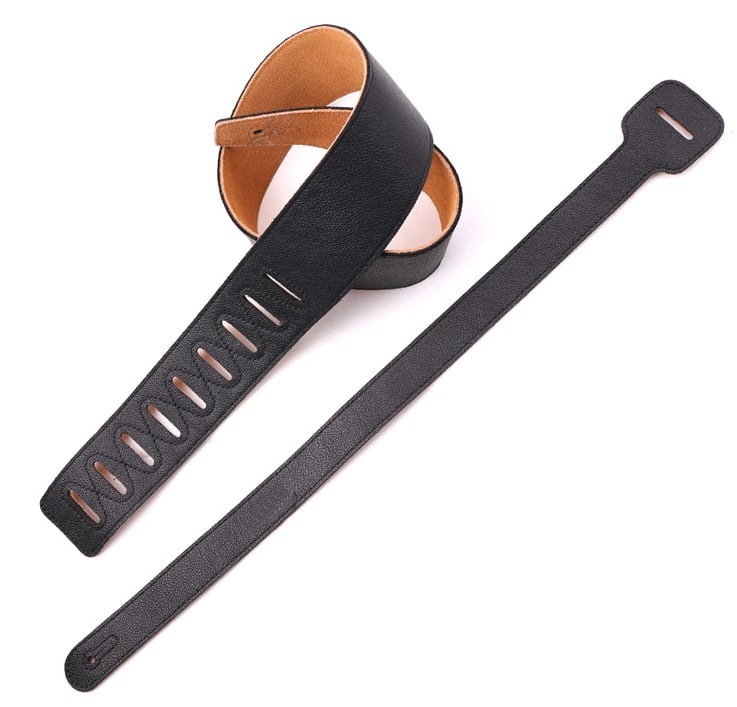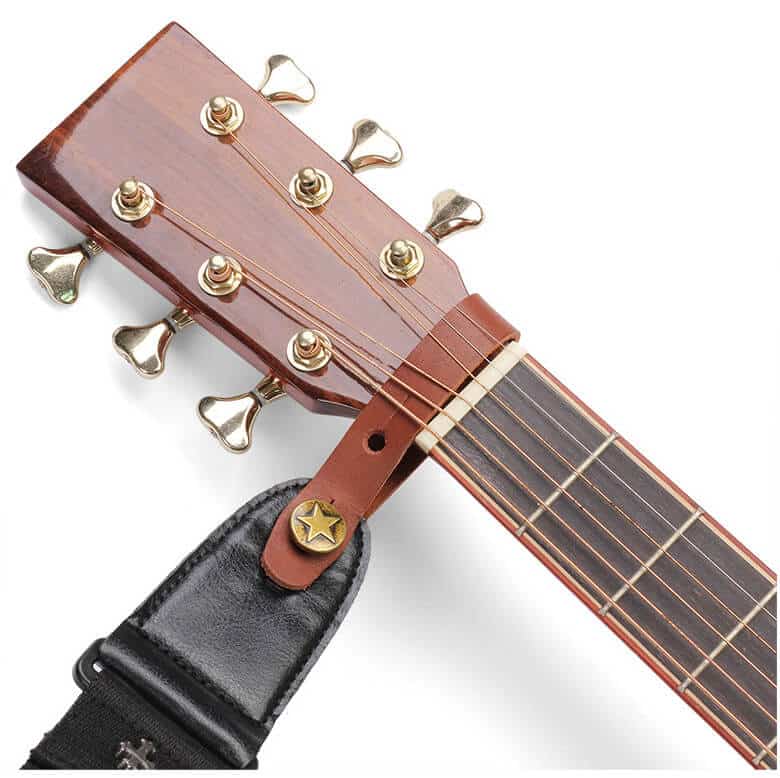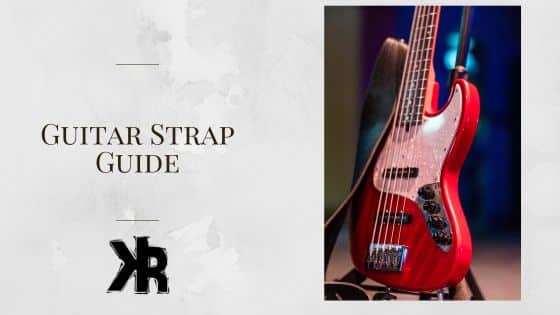Table of Contents
If you’re here, it’s likely because you are on the hunt for the perfect guitar strap. Whether you’re a seasoned player or just starting out, the importance of a good guitar strap cannot be overstated.
It’s not just about style (though that’s a big part of it), but also about comfort, versatility, and enhancing your overall playing experience.
In this Killer Rig guide, we’ll explore the world of guitar straps. Looking into their universality, the benefits they offer, and how to choose the right one for you.
We’ll also touch on the different types of straps available, and how to ensure you’re getting the best quality for your money.
So, whether you’re looking for a strap for your acoustic, electric, or bass guitar, we’ve got you covered. Let’s unravel the mystery of guitar straps together!
Are Guitar Straps Universal?
One of the most common questions we come across is, “Are guitar straps universal?” The simple answer is, yes, guitar straps are interchangeable. They are created to fit any guitar, be it electric or acoustic. However, like most things in life, there are exceptions.
Some straps are made specifically for a certain type of guitar. For instance, you might come across straps that are specifically tailored for bass guitars or smaller-sized instruments. These specific designs cater to the needs and characteristics of these instruments.
Moreover, many guitar straps come with adjustable lengths and widths. This feature ensures a secure fit, regardless of the size or shape of your guitar.
It’s always a good idea to check the specifications of any strap you’re considering buying to make sure it’s compatible with your instrument.
Remember, the goal is to find a strap that not only fits your guitar, but is also a good size for you. The right strap should feel comfortable, enhance your mobility during performances, and reflect your personal style.
The Benefits of Using a Guitar Strap
Now that we’ve established the universality of guitar straps, let’s check out the numerous benefits they offer.
Comfort and Support
One of the most notable benefits of using a guitar strap is the comfort it provides. A well-made guitar strap is designed to distribute the weight of your instrument evenly across your shoulder, reducing muscle fatigue during long playing sessions.
This is particularly beneficial for those who play standing up or move around on stage.
Versatility in Playing
A guitar strap offers a great deal of versatility, allowing you to play in a variety of positions and angles. This flexibility can open up new possibilities for your playing style, enabling you to experiment with different sounds and techniques.
Style and Aesthetics
Let’s not forget the aesthetic value of a guitar strap. A unique, stylish strap can add a personal touch to your performance and help you stand out.
Whether you prefer a classic leather strap or a vibrant, patterned design. There’s a guitar strap out there that matches your personal style.
Mobility During Performances
For those who love to move around during performances, a guitar strap is a must. It ensures that your instrument stays securely in place, giving you the freedom to express yourself on stage without worrying about your guitar slipping or shifting.
Affordability and Availability
Lastly, guitar straps are generally affordable and easy to find. They come in a wide range of prices, styles, and materials, making it easy to find one that fits your budget and preferences.

How to Choose a Guitar Strap
Selecting the right guitar strap is a personal decision that depends on various factors. Here’s a step-by-step guide to help you make an informed choice:
Consider Comfort and Fit
Comfort should be your top priority when choosing a guitar strap. Look for a strap that feels good against your body and doesn’t cause any discomfort or strain.
The fit is equally important. An adjustable strap that can be customized to your body size and playing style is usually a good choice.
Material Selection
Guitar straps are made from a variety of materials, including nylon, leather, and cotton. Each material has its own set of advantages.
Nylon straps are typically the most affordable. While leather straps are durable and offer excellent support. Cotton straps, on the other hand, are known for their breathability. Choose a material that aligns with your needs and preferences.
Width and Length Considerations
The width and length of the strap can significantly impact your comfort. Wider straps distribute the weight of the guitar more evenly, reducing pressure on your shoulder.
As for the length, it should allow you to hold the guitar at a comfortable height. Most straps are adjustable, so you can find the perfect fit.
Style and Custom Features
Your guitar strap is an extension of your personality. Choose a design that reflects your personal style.
There are countless options available, from plain straps to vibrant, patterned designs. Some straps also come with custom features, such as pockets for picks or padding for extra comfort.
Price Considerations
Guitar straps come in a wide range of prices. While it’s tempting to go for the cheapest option, remember that you often get what you pay for. Investing in a high-quality strap can provide better comfort, durability, and overall value for money.
Types of Guitar Straps
Guitar straps are integral components that ensure stability and support while playing. They come in various materials and designs, each offering specific benefits. Here’s a deeper look into the different types:
Leather Straps:
- Material: Crafted from genuine leather, these straps are known for their sturdiness and durability.
- Benefits: Over time, leather straps conform to the shape of the user’s shoulder, offering a customized fit. This natural molding process enhances comfort during prolonged playing sessions.
- Design: They often boast intricate craftsmanship, with detailed embossing or stitching, making them a popular choice among professionals.
Nylon Straps:
- Material: Made from synthetic nylon fibers, these straps are resilient and resistant to environmental factors.
- Benefits: Nylon straps are lightweight, making them easy to transport and store. Their durability ensures they can withstand regular use without significant wear.
- Design: Typically available in a wide range of colors and patterns, they cater to a diverse audience.
Cotton Straps:
- Material: Composed of natural cotton fibers.
- Benefits: Cotton is known for its breathability, making these straps comfortable for extended periods. The soft texture reduces the chances of shoulder strain.
- Design: They come in a variety of designs, from simple solid colors to intricate patterns, offering aesthetic flexibility.
Padded Straps:
- Material: These can be made from various materials but feature additional padding for comfort.
- Benefits: The extra cushioning is especially beneficial for those with heavier guitars. It ensures even weight distribution, minimizing shoulder fatigue.
- Design: Often wider than standard straps, they may have ergonomic designs to further enhance user comfort.
Bass Guitar Straps:
- Material: Crafted to support the weight of bass guitars, these are often made from robust materials.
- Benefits: Bass guitars are generally heavier than their six-string counterparts. These straps are designed to provide the necessary support without compromising on comfort.
- Design: They are wider, ensuring the weight of the instrument is evenly distributed across a larger surface area, reducing pressure points.
Each type of guitar strap offers specific advantages. When selecting a strap, it’s essential to consider the type of guitar, playing style, and individual comfort fondness.
Popular Guitar Strap Brands
When it comes to guitar straps, several brands have made a significant mark in the industry, each offering a blend of quality, design, and innovation.
Fender
Fender, a titan in the music world, offers a range of guitar straps that reflect its rich heritage.
- Often features the classic Fender logo.
- Ranges from basic designs to premium leather options.
- Suitable for various guitar types, from electric to acoustic.
Levy’s Leathers
Levy’s Leathers is synonymous with craftsmanship and quality in the world of guitar accessories.
- Specializes in high-quality leather products.
- Offers designs from simple cotton to intricate handcrafted leather.
- Special patterns and detailed embroidery are common features.
Ernie Ball
Ernie Ball, primarily known for guitar strings, has a diverse lineup of straps too.
- Durable polypropylene straps for everyday use.
- Premium Italian leather options for a touch of luxury.
- Adjustable lengths for various playing styles.
Dunlop
Dunlop is a trusted name in guitar accessories, known for durability and reliability.
- Offers basic nylon designs suitable for beginners.
- Artist series options for those seeking specific designs.
- Crafted with a focus on long-lasting quality.
Planet Waves (by D’Addario)
Planet Waves brings innovation and functionality to the forefront of guitar strap design.
- Features like auto-lock systems for added security.
- Built-in pick holders for convenience.
- Emphasis on user-friendly designs and features.
Gibson
Gibson, a legendary name in guitars, extends its commitment to quality to its range of straps.
- Often made from premium materials like leather.
- Designed to complement Gibson’s range of guitars.
- Focus on comfort and durability.
High-end vs. Affordable Guitar Straps
When it comes to guitar straps, you’ll find a wide range of options in the market, from budget-friendly choices to high-end models. But what’s the difference, and which one should you choose?
High-end Guitar Straps
High-end guitar straps are typically made from premium materials like leather or high-quality synthetic fabrics.
They often feature intricate designs, custom features, and superior craftsmanship. These straps are designed to last, offering excellent durability and comfort.
The main advantage of high-end straps is their superior quality. They’re built to withstand heavy use and often provide better support and comfort than their more affordable counterparts.
Moreover, they often come with features or designs that can add a touch of luxury to your guitar gear.
However, they can be quite expensive. If you’re on a tight budget, they might not be the best option for you.
Affordable Guitar Straps
Affordable guitar straps, on the other hand, are designed to be budget-friendly. They’re often made from less expensive materials like nylon or cotton. They may not have the same level of craftsmanship or durability as high-end straps.
That said, affordable straps can still be a great choice, especially for beginners or casual players. They offer decent comfort and support and come in a wide variety of designs. Plus, they’re easy on the wallet, making them a popular choice for those on a budget.
The main drawback of affordable options is that they may not last as long They might also lack some of the comfort features found in more expensive models.
Which End of the Guitar Strap Goes Where?
Guitar straps are essential for both comfort and functionality, but attaching them correctly is crucial for stability and ease of play. If you’ve ever been puzzled about which end of the guitar strap goes where, you’re not alone. Here’s a guide to help you out:
Standard Strap Ends
Most guitar straps come with two ends: one wider and often more ornate, and the other narrower.
Wider End:
- This end typically goes on the bottom peg of the guitar, near the base or endpin.
- The reason for this is twofold: the wider end provides better weight distribution for the heavier bottom of the guitar, and the ornate design or logo (if present) is more visible when positioned at the base.
Narrower End:
- This end attaches to the top peg, usually found on the guitar’s headstock or near the neck.
- For guitars with two pegs on the body (common in electric guitars), the narrower end attaches to the peg closest to the neck.
Specialty Straps and Attachments
Some guitar straps come with special features or attachment mechanisms:
Button Holes and Lace Ties:
While most modern straps come with button holes to attach directly to pegs, some straps offer lace ties, especially for acoustic guitars. The lace tie typically wraps around the headstock, above the nut, and secures the strap in place.
Locking Systems:
Some straps come with locking mechanisms to ensure the strap doesn’t accidentally detach during a performance. Ensure you familiarize yourself with the locking system’s operation, as the attachment process might differ slightly from standard straps.
Adjustment and Comfort
Once the strap is attached:
- Ensure it’s adjusted to a length where the guitar sits comfortably and is easily accessible for playing.
- The guitar should be stable, not tilting too much to the front or back.
- Regularly check the strap buttons or pegs on the guitar to ensure they’re tight and secure.
Additional Considerations
While we’ve covered the main factors to consider when choosing a guitar strap, there are a few additional considerations that can help you make the best choice. Let’s take a look:
Adding a Strap Button: Does it Devalue a Guitar?
Some acoustic guitars only come with one strap button. This means you’ll need to tie the other end of the strap to the headstock. If you find this setup uncomfortable, you might consider adding a second strap button.
However, keep in mind that modifying your guitar in this way could potentially devalue it, especially if it’s a high-end or vintage model. Always consult with a professional before making any modifications to your guitar.

Are Thicker Guitar Straps Better?
Thicker guitar straps can provide better weight distribution. This can be beneficial if you have a heavy guitar or play for long periods.
However, they may not be as flexible or comfortable as thinner straps. It’s a matter of personal desire, so try out different widths to see what feels best for you.
What Type of Guitar Strap is Most Comfortable?
The comfort of a guitar strap can depend on several factors, including its width, material, and adjustability. Generally, straps made from soft materials like cotton or leather tend to be more comfortable.
Straps with padding or a contoured design can also enhance comfort. However, what’s most comfortable will depend on your personal inclination and playing style.
Ultimately, the best guitar strap is one that meets your comfort needs, fits your instrument well, and aligns with your personal style. Don’t rush the decision, take your time to explore different options and find the perfect strap for you.

